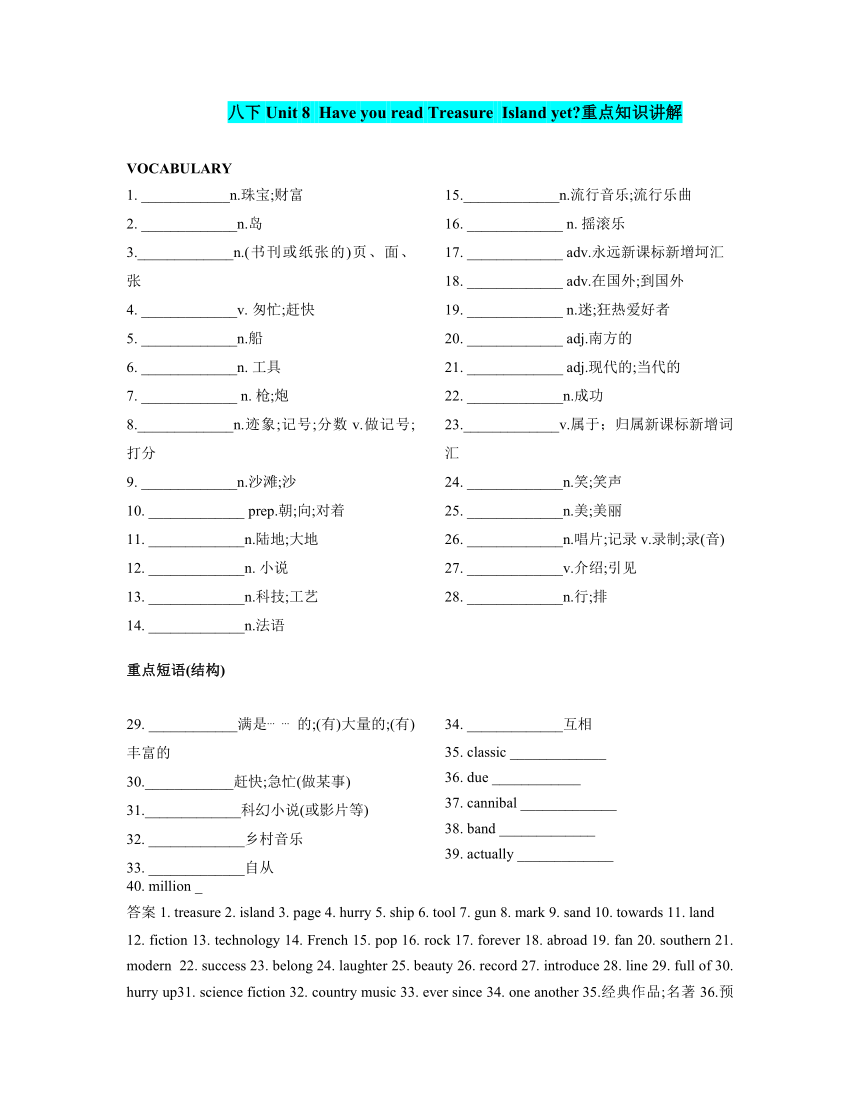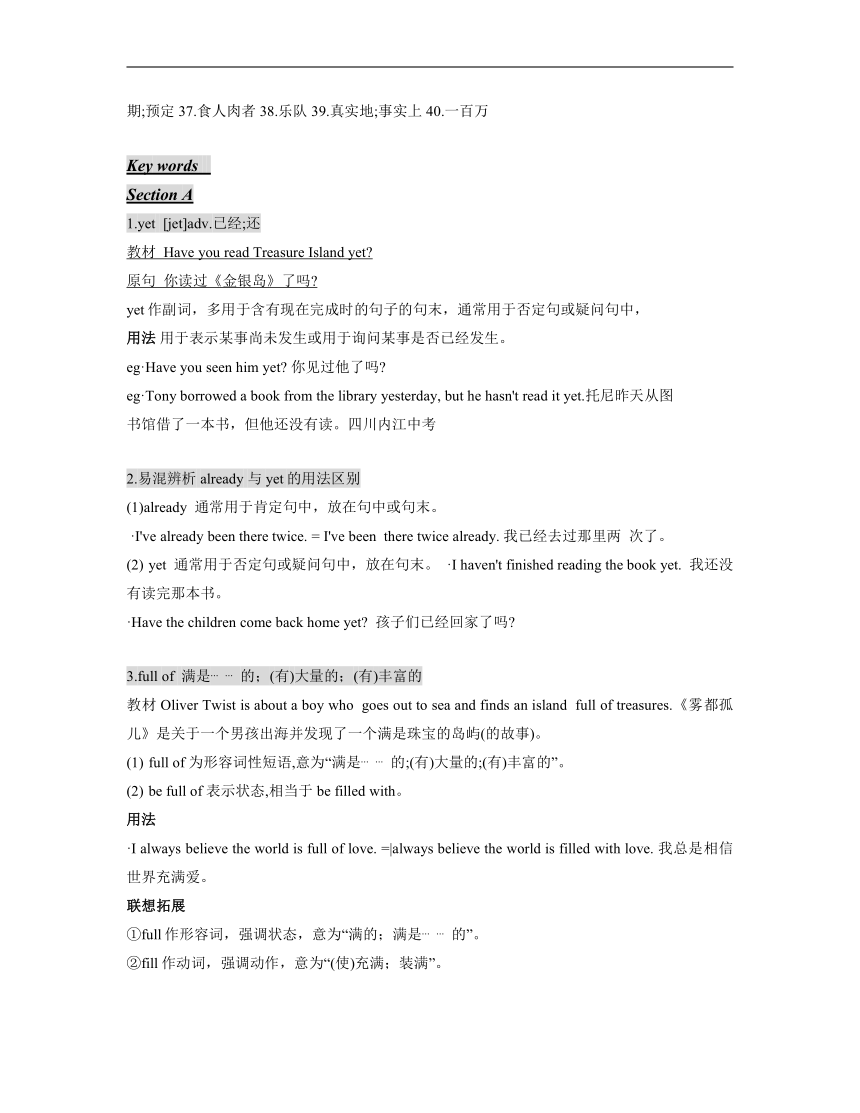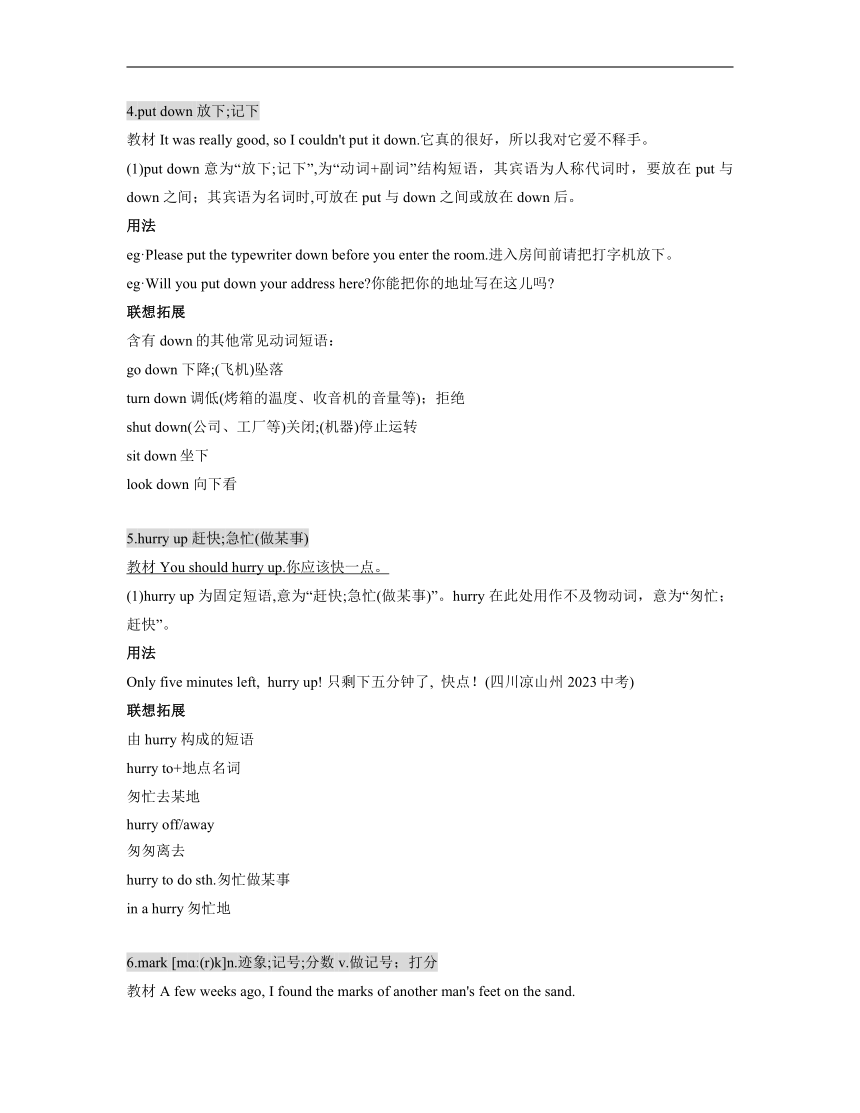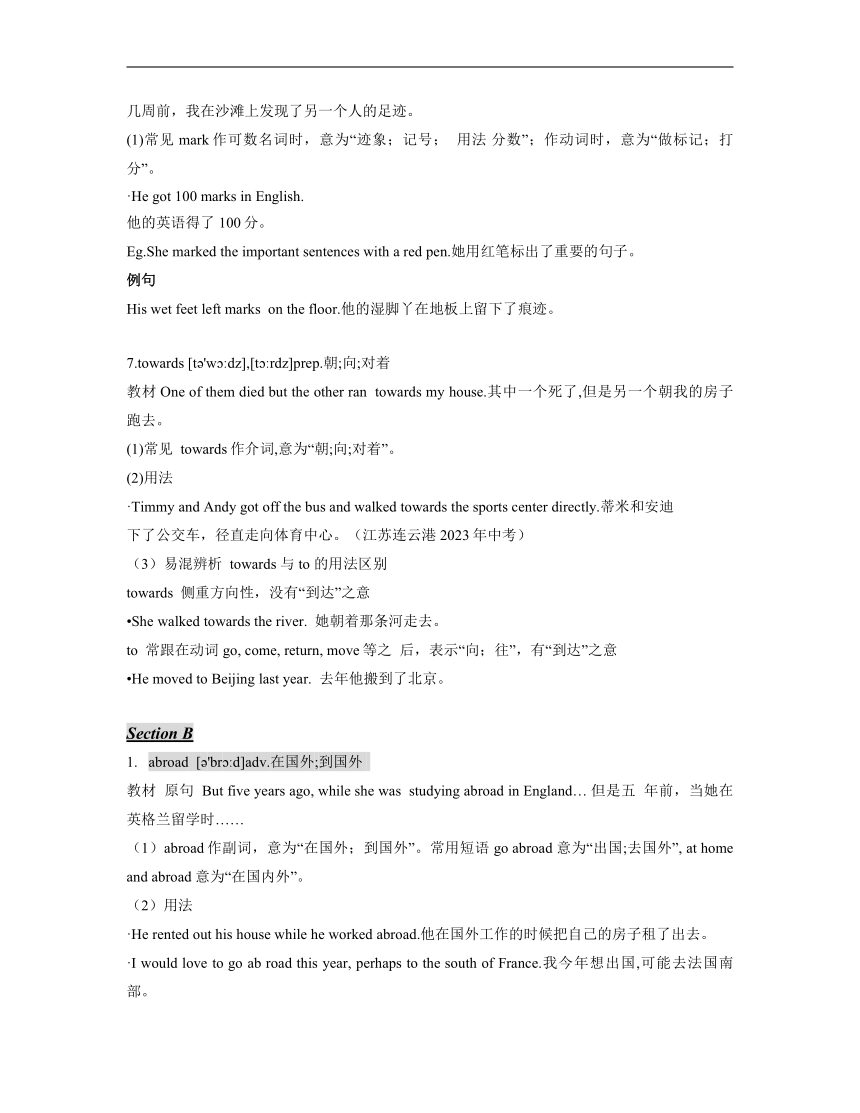人教版八年级下册Unit 8Have you read Treasure Island yet?重点知识讲解+现在完成时 (含答案)
文档属性
| 名称 | 人教版八年级下册Unit 8Have you read Treasure Island yet?重点知识讲解+现在完成时 (含答案) |  | |
| 格式 | docx | ||
| 文件大小 | 33.5KB | ||
| 资源类型 | 教案 | ||
| 版本资源 | 人教新目标(Go for it)版 | ||
| 科目 | 英语 | ||
| 更新时间 | 2024-05-31 18:31:49 | ||
图片预览




文档简介
八下Unit 8 Have you read Treasure Island yet 重点知识讲解
VOCABULARY
1. ____________n.珠宝;财富
2. _____________n.岛
3._____________n.(书刊或纸张的)页、面、张
4. _____________v. 匆忙;赶快
5. _____________n.船
6. _____________n. 工具
7. _____________ n. 枪;炮
8._____________n.迹象;记号;分数v.做记号;打分
9. _____________n.沙滩;沙
10. _____________ prep.朝;向;对着
11. _____________n.陆地;大地
12. _____________n. 小说
13. _____________n.科技;工艺
14. _____________n.法语
15._____________n.流行音乐;流行乐曲
16. _____________ n. 摇滚乐
17. _____________ adv.永远新课标新增坷汇
18. _____________ adv.在国外;到国外
19. _____________ n.迷;狂热爱好者
20. _____________ adj.南方的
21. _____________ adj.现代的;当代的
22. _____________n.成功
23._____________v.属于;归属新课标新增词汇
24. _____________n.笑;笑声
25. _____________n.美;美丽
26. _____________n.唱片;记录 v.录制;录(音)
27. _____________v.介绍;引见
28. _____________n.行;排
重点短语(结构)
29. ____________满是 的;(有)大量的;(有)丰富的
30.____________赶快;急忙(做某事)
31._____________科幻小说(或影片等)
32. _____________乡村音乐
33. _____________自从
34. _____________互相
35. classic _____________
36. due ____________
37. cannibal _____________
38. band _____________
39. actually _____________
40. million _
答案 1. treasure 2. island 3. page 4. hurry 5. ship 6. tool 7. gun 8. mark 9. sand 10. towards 11. land
12. fiction 13. technology 14. French 15. pop 16. rock 17. forever 18. abroad 19. fan 20. southern 21. modern 22. success 23. belong 24. laughter 25. beauty 26. record 27. introduce 28. line 29. full of 30. hurry up31. science fiction 32. country music 33. ever since 34. one another 35.经典作品;名著 36.预期;预定37.食人肉者 38.乐队 39.真实地;事实上 40.一百万
Key words
Section A
1.yet [jet]adv.已经;还
教材 Have you read Treasure Island yet
原句 你读过《金银岛》了吗
yet作副词,多用于含有现在完成时的句子的句末,通常用于否定句或疑问句中,
用法 用于表示某事尚未发生或用于询问某事是否已经发生。
eg·Have you seen him yet 你见过他了吗
eg·Tony borrowed a book from the library yesterday, but he hasn't read it yet.托尼昨天从图
书馆借了一本书,但他还没有读。四川内江中考
2.易混辨析 already 与 yet的用法区别
(1)already 通常用于肯定句中,放在句中或句末。
·I've already been there twice. = I've been there twice already. 我已经去过那里两 次了。
yet 通常用于否定句或疑问句中,放在句末。 ·I haven't finished reading the book yet. 我还没有读完那本书。
·Have the children come back home yet 孩子们已经回家了吗
3.full of 满是 的;(有)大量的;(有)丰富的
教材Oliver Twist is about a boy who goes out to sea and finds an island full of treasures.《雾都孤儿》是关于一个男孩出海并发现了一个满是珠宝的岛屿(的故事)。
full of 为形容词性短语,意为“满是 的;(有)大量的;(有)丰富的”。
be full of 表示状态,相当于 be filled with。
用法
·I always believe the world is full of love. =|always believe the world is filled with love. 我总是相信世界充满爱。
联想拓展
①full作形容词,强调状态,意为“满的;满是 的”。
②fill作动词,强调动作,意为“(使)充满;装满”。
4.put down 放下;记下
教材It was really good, so I couldn't put it down.它真的很好,所以我对它爱不释手。
(1)put down 意为“放下;记下”,为“动词+副词”结构短语,其宾语为人称代词时,要放在put 与 down 之间;其宾语为名词时,可放在 put 与 down 之间或放在down 后。
用法
eg·Please put the typewriter down before you enter the room.进入房间前请把打字机放下。
eg·Will you put down your address here 你能把你的地址写在这儿吗
联想拓展
含有 down的其他常见动词短语:
go down 下降;(飞机)坠落
turn down调低(烤箱的温度、收音机的音量等);拒绝
shut down(公司、工厂等)关闭;(机器)停止运转
sit down坐下
look down 向下看
5.hurry up 赶快;急忙(做某事)
教材You should hurry up.你应该快一点。
(1)hurry up 为固定短语,意为“赶快;急忙(做某事)”。hurry 在此处用作不及物动词,意为“匆忙;赶快”。
用法
Only five minutes left, hurry up! 只剩下五分钟了, 快点!(四川凉山州2023中考)
联想拓展
由 hurry 构成的短语
hurry to+地点名词
匆忙去某地
hurry off/away
匆匆离去
hurry to do sth.匆忙做某事
in a hurry匆忙地
6.mark [mɑ (r)k]n.迹象;记号;分数 v.做记号;打分
教材 A few weeks ago, I found the marks of another man's feet on the sand.
几周前,我在沙滩上发现了另一个人的足迹。
(1)常见 mark作可数名词时,意为“迹象;记号; 用法 分数”;作动词时,意为“做标记;打分”。
·He got 100 marks in English.
他的英语得了100分。
Eg.She marked the important sentences with a red pen.她用红笔标出了重要的句子。
例句
His wet feet left marks on the floor.他的湿脚丫在地板上留下了痕迹。
7.towards [t 'w dz],[t rdz]prep.朝;向;对着
教材One of them died but the other ran towards my house.其中一个死了,但是另一个朝我的房子跑去。
(1)常见 towards作介词,意为“朝;向;对着”。
(2)用法
·Timmy and Andy got off the bus and walked towards the sports center directly.蒂米和安迪
下了公交车,径直走向体育中心。(江苏连云港2023年中考)
(3)易混辨析 towards 与 to 的用法区别
towards 侧重方向性,没有“到达”之意
She walked towards the river. 她朝着那条河走去。
to 常跟在动词go, come, return, move等之 后,表示“向;往”,有“到达”之意
He moved to Beijing last year. 去年他搬到了北京。
Section B
abroad [ 'br d]adv.在国外;到国外
教材 原句 But five years ago, while she was studying abroad in England… 但是五 年前,当她在英格兰留学时……
(1)abroad作副词,意为“在国外;到国外”。常用短语 go abroad 意为“出国;去国外”, at home and abroad 意为“在国内外”。
(2)用法
·He rented out his house while he worked abroad.他在国外工作的时候把自己的房子租了出去。
·I would love to go ab road this year, perhaps to the south of France.我今年想出国,可能去法国南部。
·Huangguoshu Waterfall is widely known to people from home and abroad.黄果树瀑布为国
内外的人们所熟知。贵州贵阳中考
(3)Note:abroad 不能与in, to, at等介词连用,其前也不加冠词,但其前可用介词from。
2.ever since 自从
教材Ever since then, she has been a fan of American country music. 从那之后,她就成了一名美国乡村音乐的狂热爱好者。
(1)ever since 意为“自从”,相当于 since,ever 起强调作用。ever since 后可接表示过去的时间点,也可接时态为一般过去时的句子,此时主句常用现在完成时,并且主句的谓语部分应用延续性动词,或表示状态的动词或短语。
(2)用法
·We've been friends ever since we met at school.自从我们在学校认识之后,我们就一直是
朋友。
.Ever since “ Mother Nature”gave me life, I expected to grow tall and big. 自从“大自然母 亲”给了我生命后,我就期望自己长得又高又大。湖北宜昌2023中考
4.belong to 属于
教材Many songs these days are just about modern life in the US, such as the importance of money and
success, but not about belonging to a group.现在的许多歌曲都只是关于美国现代生活的,例如金钱和成功的重要性,而不是关于归属某个群体的。
(1)belong to 一般不用于进行时态以及被动语态,常用于以下几种情况:
①belong to 意为“属于”,其中 to 是介词,后面一般接名词或人称代词作宾语。
②belong to 后还可跟表示团队、组织、地域等的名词,表示“是……的成员;来自
(某个团体或组织)”。
③“物+belong(s)/belonged to+人”可转换为“物+be+名词所有格或名词性物主代词”。
(2)用法
.Does this book belong to you
这本书是你的吗
·—Whose is this toy truck
这辆玩具卡车是谁的
—It must belong to Dick. He was the only little kid at the picnic.它一定是迪克的。他是野餐中
唯一的小孩。湖北鄂州中考
.She belongs to the school computer club.
她是学校计算机俱乐部的成员。
·The house belongs to my uncle. = The house is my uncle's.这栋房子是我叔叔的。
5.million ['m lj n]num.一百万
教材He's sold more than 120 million records.他已经售出了超过1.2亿张唱片。
常见 用法
million为数词,意为“一百万”,当其前面 有具体的基数词修饰时, million 后不能 加s。
.—What is the population of Guizhou
贵州的人口有多少
—It has more than thirty-eight million people.
贵州有3,800多万人。贵州黔东南州2023中考
联想拓展
millions of 表示不确定的数量,意为“数百万的”,此时 million 必须用复数形式,且前面
不能再用具体的基数词修饰。与 million 用法类似的还有 hundred(百), thousand(千) 和 billion(十
亿)等。
·If someone loves a flower, of which just one single blosso m grows in all the millions and millions of stars, it is enough to make him happy just to look at the stars.倘若一个人对一朵花情有独钟,而那花在浩瀚的星河中,是独一无二的,那么,他只要仰望繁星点点,就心满意足了。选自名著《小王子》
Note:模糊数字两有(有s,有 of),具体数字两无(无s,无 of)。
6.introduce[ ntr 'dju s, ntr 'du s] v. 介绍;引见
教材 Have you introduced this singer/writer to others 你把这位歌手/作家介绍给其他人了吗
常见 用法 i
ntroduce 作动词,意为“介绍;引见”。 introduce... to ... 意为“把······介绍 给 ”; introduce oneself 意为“介绍 某人自己;自我介绍”。
·Let me introduce my friend to you.
让我把我的朋友介绍给你。
·Mum joined our little group and introduced herself to our new friends.妈妈加入了我们的小
团体并向我们的新朋友作了自我介绍。联想拓展 ①introduce 还可意为“首次引入(某物);使传入”,常见短语为 introduce sth. to/into sth.。
·When was coffee introduced into Britain
咖啡是什么时候传入英国的
②introduce 的名词形式为 introduction,意为“介绍;引进;初次传入的东西”。
·Our first contestant needs no introduction.
我们的第一位参赛者就不用介绍了。
.Potatoes were a 16th-century introduction to Europe.马铃薯是16世纪传入欧洲的。
Key sentences and phrases
一、see sb. doing sth.与 see sb. do sth.
教材Not long after that, I saw some cannibals trying to kill two men from a broken ship.在那之后不久,我看到一些食人肉者正要设法杀掉来自一艘破船上的两个人。
①see sb. doing sth.意为“看见某人正 在做某事”,用现在分词作宾语补足语, 表示看见动作正在进行。
②see sb. do sth.意为“看见某人做某 事”,表示看见动作发生的全过程或经常 看见某动作发生。
·I saw him working in the garden yesterday when I passed by.昨天经过时,我看见他正在花园里干活。(强调“我”看见他正在干活)
.I saw him work in the garden yesterday.昨天我看见他在花园里干活了。(强调“我”看见了他干活的全过程)
(1)联想拓展 与 see 用法类似的动词还有 watch,notice, hear等。
·Last night when my father was reading a newspaper, he suddenly heard someone crying for help.昨天晚上我爸爸正在读报纸时,他突然听到有人大声呼救。
二、can't wait to do sth.结构
教材…Sally looks at the many books she has not read yet and she can't wait to read them! ……萨莉看着这么多她还没有读过的书,迫不及待地想要读它们!
(1)句式 can't wait to do sth.意为“迫不及待地做某事”。
·The kids can't wait to open the box.
孩子们迫不及待地打开了那个箱子。
·—Why are you so excited
你为什么这么兴奋
—The scientist Huang Xuhua will come to our school. I can't wait to see him.科学家黄旭华将来我们学校。我等不及要见他了。湖北鄂州中考
联想拓展
①can't wait for sth.意为“等不及某事/物”,for 后常接名词或名词短语。
·The children can't wait for Children's Day to come.孩子们等儿童节都等不及了。
②can't help doing sth.意为“忍不住做某事”。
·I couldn't help thinking about the past.
我不禁回想起过去。
GRAMMAR语法
现在完成时
教材—Have you read Little Women yet
你读过《小妇人》了吗
—No, I haven't. 不,我没有。
1.现在完成时的用法
现在完成时用于表示过去发生或已经完成的动作对现在造成的影响或结果,或表示从过去某一
时间开始并一直持续到现在的动作或状态,常与just, yet, ever, never, already, so far, by now 等连用。
2.现在完成时的构成
现在完成时由“助动词have/has+动词的过去分词”构成。
口诀巧记忆
现在完成时的构成和标志
have/has在前面,过去分词在后面,
以前(before)从来不(never)出现,
最近( recently ) 曾经 ( ever ) 一 ( once ) 两遍(twice),
自从(since)刚刚(just)时间段(for+时间段),
迄今(by now/so far)已经(already/yet)很明显。
3.现在完成时的基本句型
句 型 结 构 例 句
肯定句 主语+have/has+ 动词过去分词(+ 其他).
·I have already watched the movie. 我已 经 看过这部 电 影了。
否定句 主语+have/has+ not+动词过去分 词(+其他).
·I haven't seen our dog since yesterday. 我从昨天起就没见过 我们的狗。
一般 疑问句 —Have/Has +主 语+动词过去分 词(+其他) —Yes,主语+have/ has./No, 主语+ haven't/hasn't.
·—Have you made many friends in this new school 你在这 所新学校交了很多朋 友吗 —Yes, I have./No, I haven't. 是 的, 我 交 了。/不,我没有。
特殊疑问句 特殊疑问词+have/ has+主语+动词 过去分词( +其 他)
·Where have you been during the holiday 假期你去哪里了
4.现在完成时和一般过去时的区别
现在完成时 一般过去时
意义
现在完成时强调过去 发生或已经完成的动 作对现在造成的影响 或结果。 标志词或短语 “ for + 时 间 段 ”, since, so far, ever, never, just, yet, up to now, in the past few years等。
一般过去时表示过去 发生的动作或单纯叙 述过去的事情。 标志词或短语 yesterday, last week, ago, in 1980, just now等
VOCABULARY
1. ____________n.珠宝;财富
2. _____________n.岛
3._____________n.(书刊或纸张的)页、面、张
4. _____________v. 匆忙;赶快
5. _____________n.船
6. _____________n. 工具
7. _____________ n. 枪;炮
8._____________n.迹象;记号;分数v.做记号;打分
9. _____________n.沙滩;沙
10. _____________ prep.朝;向;对着
11. _____________n.陆地;大地
12. _____________n. 小说
13. _____________n.科技;工艺
14. _____________n.法语
15._____________n.流行音乐;流行乐曲
16. _____________ n. 摇滚乐
17. _____________ adv.永远新课标新增坷汇
18. _____________ adv.在国外;到国外
19. _____________ n.迷;狂热爱好者
20. _____________ adj.南方的
21. _____________ adj.现代的;当代的
22. _____________n.成功
23._____________v.属于;归属新课标新增词汇
24. _____________n.笑;笑声
25. _____________n.美;美丽
26. _____________n.唱片;记录 v.录制;录(音)
27. _____________v.介绍;引见
28. _____________n.行;排
重点短语(结构)
29. ____________满是 的;(有)大量的;(有)丰富的
30.____________赶快;急忙(做某事)
31._____________科幻小说(或影片等)
32. _____________乡村音乐
33. _____________自从
34. _____________互相
35. classic _____________
36. due ____________
37. cannibal _____________
38. band _____________
39. actually _____________
40. million _
答案 1. treasure 2. island 3. page 4. hurry 5. ship 6. tool 7. gun 8. mark 9. sand 10. towards 11. land
12. fiction 13. technology 14. French 15. pop 16. rock 17. forever 18. abroad 19. fan 20. southern 21. modern 22. success 23. belong 24. laughter 25. beauty 26. record 27. introduce 28. line 29. full of 30. hurry up31. science fiction 32. country music 33. ever since 34. one another 35.经典作品;名著 36.预期;预定37.食人肉者 38.乐队 39.真实地;事实上 40.一百万
Key words
Section A
1.yet [jet]adv.已经;还
教材 Have you read Treasure Island yet
原句 你读过《金银岛》了吗
yet作副词,多用于含有现在完成时的句子的句末,通常用于否定句或疑问句中,
用法 用于表示某事尚未发生或用于询问某事是否已经发生。
eg·Have you seen him yet 你见过他了吗
eg·Tony borrowed a book from the library yesterday, but he hasn't read it yet.托尼昨天从图
书馆借了一本书,但他还没有读。四川内江中考
2.易混辨析 already 与 yet的用法区别
(1)already 通常用于肯定句中,放在句中或句末。
·I've already been there twice. = I've been there twice already. 我已经去过那里两 次了。
yet 通常用于否定句或疑问句中,放在句末。 ·I haven't finished reading the book yet. 我还没有读完那本书。
·Have the children come back home yet 孩子们已经回家了吗
3.full of 满是 的;(有)大量的;(有)丰富的
教材Oliver Twist is about a boy who goes out to sea and finds an island full of treasures.《雾都孤儿》是关于一个男孩出海并发现了一个满是珠宝的岛屿(的故事)。
full of 为形容词性短语,意为“满是 的;(有)大量的;(有)丰富的”。
be full of 表示状态,相当于 be filled with。
用法
·I always believe the world is full of love. =|always believe the world is filled with love. 我总是相信世界充满爱。
联想拓展
①full作形容词,强调状态,意为“满的;满是 的”。
②fill作动词,强调动作,意为“(使)充满;装满”。
4.put down 放下;记下
教材It was really good, so I couldn't put it down.它真的很好,所以我对它爱不释手。
(1)put down 意为“放下;记下”,为“动词+副词”结构短语,其宾语为人称代词时,要放在put 与 down 之间;其宾语为名词时,可放在 put 与 down 之间或放在down 后。
用法
eg·Please put the typewriter down before you enter the room.进入房间前请把打字机放下。
eg·Will you put down your address here 你能把你的地址写在这儿吗
联想拓展
含有 down的其他常见动词短语:
go down 下降;(飞机)坠落
turn down调低(烤箱的温度、收音机的音量等);拒绝
shut down(公司、工厂等)关闭;(机器)停止运转
sit down坐下
look down 向下看
5.hurry up 赶快;急忙(做某事)
教材You should hurry up.你应该快一点。
(1)hurry up 为固定短语,意为“赶快;急忙(做某事)”。hurry 在此处用作不及物动词,意为“匆忙;赶快”。
用法
Only five minutes left, hurry up! 只剩下五分钟了, 快点!(四川凉山州2023中考)
联想拓展
由 hurry 构成的短语
hurry to+地点名词
匆忙去某地
hurry off/away
匆匆离去
hurry to do sth.匆忙做某事
in a hurry匆忙地
6.mark [mɑ (r)k]n.迹象;记号;分数 v.做记号;打分
教材 A few weeks ago, I found the marks of another man's feet on the sand.
几周前,我在沙滩上发现了另一个人的足迹。
(1)常见 mark作可数名词时,意为“迹象;记号; 用法 分数”;作动词时,意为“做标记;打分”。
·He got 100 marks in English.
他的英语得了100分。
Eg.She marked the important sentences with a red pen.她用红笔标出了重要的句子。
例句
His wet feet left marks on the floor.他的湿脚丫在地板上留下了痕迹。
7.towards [t 'w dz],[t rdz]prep.朝;向;对着
教材One of them died but the other ran towards my house.其中一个死了,但是另一个朝我的房子跑去。
(1)常见 towards作介词,意为“朝;向;对着”。
(2)用法
·Timmy and Andy got off the bus and walked towards the sports center directly.蒂米和安迪
下了公交车,径直走向体育中心。(江苏连云港2023年中考)
(3)易混辨析 towards 与 to 的用法区别
towards 侧重方向性,没有“到达”之意
She walked towards the river. 她朝着那条河走去。
to 常跟在动词go, come, return, move等之 后,表示“向;往”,有“到达”之意
He moved to Beijing last year. 去年他搬到了北京。
Section B
abroad [ 'br d]adv.在国外;到国外
教材 原句 But five years ago, while she was studying abroad in England… 但是五 年前,当她在英格兰留学时……
(1)abroad作副词,意为“在国外;到国外”。常用短语 go abroad 意为“出国;去国外”, at home and abroad 意为“在国内外”。
(2)用法
·He rented out his house while he worked abroad.他在国外工作的时候把自己的房子租了出去。
·I would love to go ab road this year, perhaps to the south of France.我今年想出国,可能去法国南部。
·Huangguoshu Waterfall is widely known to people from home and abroad.黄果树瀑布为国
内外的人们所熟知。贵州贵阳中考
(3)Note:abroad 不能与in, to, at等介词连用,其前也不加冠词,但其前可用介词from。
2.ever since 自从
教材Ever since then, she has been a fan of American country music. 从那之后,她就成了一名美国乡村音乐的狂热爱好者。
(1)ever since 意为“自从”,相当于 since,ever 起强调作用。ever since 后可接表示过去的时间点,也可接时态为一般过去时的句子,此时主句常用现在完成时,并且主句的谓语部分应用延续性动词,或表示状态的动词或短语。
(2)用法
·We've been friends ever since we met at school.自从我们在学校认识之后,我们就一直是
朋友。
.Ever since “ Mother Nature”gave me life, I expected to grow tall and big. 自从“大自然母 亲”给了我生命后,我就期望自己长得又高又大。湖北宜昌2023中考
4.belong to 属于
教材Many songs these days are just about modern life in the US, such as the importance of money and
success, but not about belonging to a group.现在的许多歌曲都只是关于美国现代生活的,例如金钱和成功的重要性,而不是关于归属某个群体的。
(1)belong to 一般不用于进行时态以及被动语态,常用于以下几种情况:
①belong to 意为“属于”,其中 to 是介词,后面一般接名词或人称代词作宾语。
②belong to 后还可跟表示团队、组织、地域等的名词,表示“是……的成员;来自
(某个团体或组织)”。
③“物+belong(s)/belonged to+人”可转换为“物+be+名词所有格或名词性物主代词”。
(2)用法
.Does this book belong to you
这本书是你的吗
·—Whose is this toy truck
这辆玩具卡车是谁的
—It must belong to Dick. He was the only little kid at the picnic.它一定是迪克的。他是野餐中
唯一的小孩。湖北鄂州中考
.She belongs to the school computer club.
她是学校计算机俱乐部的成员。
·The house belongs to my uncle. = The house is my uncle's.这栋房子是我叔叔的。
5.million ['m lj n]num.一百万
教材He's sold more than 120 million records.他已经售出了超过1.2亿张唱片。
常见 用法
million为数词,意为“一百万”,当其前面 有具体的基数词修饰时, million 后不能 加s。
.—What is the population of Guizhou
贵州的人口有多少
—It has more than thirty-eight million people.
贵州有3,800多万人。贵州黔东南州2023中考
联想拓展
millions of 表示不确定的数量,意为“数百万的”,此时 million 必须用复数形式,且前面
不能再用具体的基数词修饰。与 million 用法类似的还有 hundred(百), thousand(千) 和 billion(十
亿)等。
·If someone loves a flower, of which just one single blosso m grows in all the millions and millions of stars, it is enough to make him happy just to look at the stars.倘若一个人对一朵花情有独钟,而那花在浩瀚的星河中,是独一无二的,那么,他只要仰望繁星点点,就心满意足了。选自名著《小王子》
Note:模糊数字两有(有s,有 of),具体数字两无(无s,无 of)。
6.introduce[ ntr 'dju s, ntr 'du s] v. 介绍;引见
教材 Have you introduced this singer/writer to others 你把这位歌手/作家介绍给其他人了吗
常见 用法 i
ntroduce 作动词,意为“介绍;引见”。 introduce... to ... 意为“把······介绍 给 ”; introduce oneself 意为“介绍 某人自己;自我介绍”。
·Let me introduce my friend to you.
让我把我的朋友介绍给你。
·Mum joined our little group and introduced herself to our new friends.妈妈加入了我们的小
团体并向我们的新朋友作了自我介绍。联想拓展 ①introduce 还可意为“首次引入(某物);使传入”,常见短语为 introduce sth. to/into sth.。
·When was coffee introduced into Britain
咖啡是什么时候传入英国的
②introduce 的名词形式为 introduction,意为“介绍;引进;初次传入的东西”。
·Our first contestant needs no introduction.
我们的第一位参赛者就不用介绍了。
.Potatoes were a 16th-century introduction to Europe.马铃薯是16世纪传入欧洲的。
Key sentences and phrases
一、see sb. doing sth.与 see sb. do sth.
教材Not long after that, I saw some cannibals trying to kill two men from a broken ship.在那之后不久,我看到一些食人肉者正要设法杀掉来自一艘破船上的两个人。
①see sb. doing sth.意为“看见某人正 在做某事”,用现在分词作宾语补足语, 表示看见动作正在进行。
②see sb. do sth.意为“看见某人做某 事”,表示看见动作发生的全过程或经常 看见某动作发生。
·I saw him working in the garden yesterday when I passed by.昨天经过时,我看见他正在花园里干活。(强调“我”看见他正在干活)
.I saw him work in the garden yesterday.昨天我看见他在花园里干活了。(强调“我”看见了他干活的全过程)
(1)联想拓展 与 see 用法类似的动词还有 watch,notice, hear等。
·Last night when my father was reading a newspaper, he suddenly heard someone crying for help.昨天晚上我爸爸正在读报纸时,他突然听到有人大声呼救。
二、can't wait to do sth.结构
教材…Sally looks at the many books she has not read yet and she can't wait to read them! ……萨莉看着这么多她还没有读过的书,迫不及待地想要读它们!
(1)句式 can't wait to do sth.意为“迫不及待地做某事”。
·The kids can't wait to open the box.
孩子们迫不及待地打开了那个箱子。
·—Why are you so excited
你为什么这么兴奋
—The scientist Huang Xuhua will come to our school. I can't wait to see him.科学家黄旭华将来我们学校。我等不及要见他了。湖北鄂州中考
联想拓展
①can't wait for sth.意为“等不及某事/物”,for 后常接名词或名词短语。
·The children can't wait for Children's Day to come.孩子们等儿童节都等不及了。
②can't help doing sth.意为“忍不住做某事”。
·I couldn't help thinking about the past.
我不禁回想起过去。
GRAMMAR语法
现在完成时
教材—Have you read Little Women yet
你读过《小妇人》了吗
—No, I haven't. 不,我没有。
1.现在完成时的用法
现在完成时用于表示过去发生或已经完成的动作对现在造成的影响或结果,或表示从过去某一
时间开始并一直持续到现在的动作或状态,常与just, yet, ever, never, already, so far, by now 等连用。
2.现在完成时的构成
现在完成时由“助动词have/has+动词的过去分词”构成。
口诀巧记忆
现在完成时的构成和标志
have/has在前面,过去分词在后面,
以前(before)从来不(never)出现,
最近( recently ) 曾经 ( ever ) 一 ( once ) 两遍(twice),
自从(since)刚刚(just)时间段(for+时间段),
迄今(by now/so far)已经(already/yet)很明显。
3.现在完成时的基本句型
句 型 结 构 例 句
肯定句 主语+have/has+ 动词过去分词(+ 其他).
·I have already watched the movie. 我已 经 看过这部 电 影了。
否定句 主语+have/has+ not+动词过去分 词(+其他).
·I haven't seen our dog since yesterday. 我从昨天起就没见过 我们的狗。
一般 疑问句 —Have/Has +主 语+动词过去分 词(+其他) —Yes,主语+have/ has./No, 主语+ haven't/hasn't.
·—Have you made many friends in this new school 你在这 所新学校交了很多朋 友吗 —Yes, I have./No, I haven't. 是 的, 我 交 了。/不,我没有。
特殊疑问句 特殊疑问词+have/ has+主语+动词 过去分词( +其 他)
·Where have you been during the holiday 假期你去哪里了
4.现在完成时和一般过去时的区别
现在完成时 一般过去时
意义
现在完成时强调过去 发生或已经完成的动 作对现在造成的影响 或结果。 标志词或短语 “ for + 时 间 段 ”, since, so far, ever, never, just, yet, up to now, in the past few years等。
一般过去时表示过去 发生的动作或单纯叙 述过去的事情。 标志词或短语 yesterday, last week, ago, in 1980, just now等
同课章节目录
- Unit 1 What's the matter?
- Section A
- Section B
- Unit 2 I'll help to clean up the city parks.
- Section A
- Section B
- Unit 3 Could you please clean your room?
- Section A
- Section B
- Unit 4 Why don't you talk to your parents?
- Section A
- Section B
- Unit 5 What were you doing when the rainstorm came
- Section A
- Section B
- Review of Units 1-5
- Unit 6 An old man tried to move the mountains.
- Section A
- Section B
- Unit 7 What's the highest mountain in the world?
- Section A
- Section B
- Unit 8 Have you read Treasure Island yet?
- Section A
- Section B
- Unit 9 Have you ever been to a museum?
- Section A
- Section B
- Unit 10 I've had this bike for three years.
- Section A
- Section B
